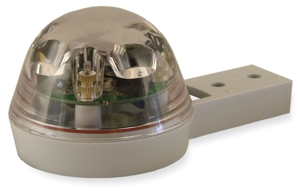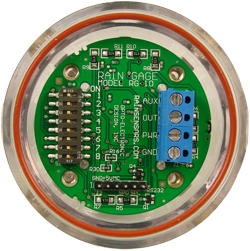Buy Now
General Description
 The RG-11 is a novel, futuristic and relatively inexpensive optical rain sensor, pictured right. This sensor has particular appeal for hobbyists and experimentalists, including those who need a sensor to trigger some electromechanical action when it starts to rain, as well as for more traditional weather-monitoring applications.
The RG-11 is a novel, futuristic and relatively inexpensive optical rain sensor, pictured right. This sensor has particular appeal for hobbyists and experimentalists, including those who need a sensor to trigger some electromechanical action when it starts to rain, as well as for more traditional weather-monitoring applications.
The sensor design consists of a clear hemispherical dome – about 7cm (2.75 inches) in diameter and with the whole assembly about 12cm (4.5″) long, to give some idea of scale – within which a set of four light beams are reflected and constantly monitored. The dome also covers a circular circuit board (see below), both attached to a sturdy grey plastic mounting bracket. When rain or some other cause of water droplets (for example dew or condensation) start to form on the outside of the dome, the beam reflection pattern changes in a subtle yet detailed way which can be translated by onboard circuitry and firmware into a carefully-processed output signal. As the water droplets run off or evaporate or are replaced by fresh droplets so the reflection pattern changes and is continuously monitored, with outputs triggered accordingly – see below for a more detailed description.
The sensor output is provided by contact closure of a built-in miniature relay with contacts rated at 24v DC and 1A. The output can be connected to a low-voltage circuit such as a counter module for further processing or, alternatively, used to control some external device directly. (Obviously to switch AC mains devices an intermediate heavy-duty relay or solid-state equivalent would need to be used.)
Because of its optical basis– not mechanical, chemical, or conductive, the RG-11 sensor is far more rugged, sensitive and reliable than other technologies. The sensor is extremely sensitive, and virtually immune to false trips. Yet, it is completely unaffected by jostling and motion. There are no exposed conductors to corrode, and no openings for bugs to crawl into. Similarly, there is no place for leaves or other debris to collect. Therefore, once assembled and attached to a suitable mounting point by means of the mounting holes provided in the bracket, the RG-11 sensor is fully weather-proof and can be left outside to continue operation for extended periods, needing absolutely no maintenance or other attention. (NB For maximum accuracy, it is recommended that the dome be given a fresh coat of RainX once per year.)
The RG-11 sensor is available to buy from our online shop or contact us for further information. All RG-11 sensors we ship will have the latest SW011 firmware and RainX treatment.
Applications
Please note that the RG-11 is not marketed as a highly accurate rain gauge, which it does not claim to be (although the RG-11 sensor is able to make respectable estimates of rainfall; accuracy in TBR mode has also been further improved by RainX treatment of the dome and associated firmware updates). Rather, the RG-11 is aimed at three categories of application:
- As a potential substitute for a standard automatic gauge under circumstances where robust, long-term and essentially maintenance-free operation is a higher priority than ultimate accuracy;
- As an adjunct and backup to an existing automatic gauge when the extra sensitivity of the RG-11 can provide more detailed records, for example during minimal rainfall or light/heavy dew events;
- For controlling electrometrical devices during rainfall events or in related circumstances, e.g. when condensation may occur;
There may well be other applications for which the RG-11 sensor is suitable; the RG-11 is a new product for us and we have almost certainly not yet identified all potential applications – please let us know if you have some further novel ideas for using this device.
 The RG-11 can be set to operate in six different regimes, as detailed below. Each regime corresponds to a different closure pattern of the relay contacts (number and timing of closure pulses) in response to the rain/water droplets sensed. These various modes of operation are programmed by the DIP switch positions to the left of the main RG-11 circuit board – see picture right. (The blue terminal block to the right is where the four wire connections to the sensor are made.)
The RG-11 can be set to operate in six different regimes, as detailed below. Each regime corresponds to a different closure pattern of the relay contacts (number and timing of closure pulses) in response to the rain/water droplets sensed. These various modes of operation are programmed by the DIP switch positions to the left of the main RG-11 circuit board – see picture right. (The blue terminal block to the right is where the four wire connections to the sensor are made.)
- Mode 0 – Tipping Bucket Rain Gauge Mode: Tipping increments of 0.2, 0.01 and even 0.001mm – and inch equivalents – are all possible!
- Mode 1 – ‘Is it raining?’ sensor with variable sensitivity to rainfall rate;
- Mode 2 – Condensation sensor, again with variable sensitivity;
- Mode 3 – Wiper control;
- Mode 4 – Irrigation control;
- Mode 5 – Drop mode: Effectively a raw data mode where the contact closures pass through the drop detection signals and allow the raw drop data to be processed externally;
Please be aware that the RG-11 does need a source of external power (e.g. 12v 15mA) for operation, although there is also a slightly less sensitive ‘micro-power’ mode that can be set which should allow operation from a 9v battery at 1.5mA current draw. (NB There is no battery housing provided within the RG-11 sensor – users must make their own provision for powering the sensor.)
Further information
A PDF copy of the instruction manual for the RG-11 rain sensor can be downloaded here: rg-11_instructions.
A small US-based section of the main WXforum website has recently been established specifically to discuss the RG-11 sensor. This forum may be viewed at: www.wxforum.net/index.php?board=108.0.
